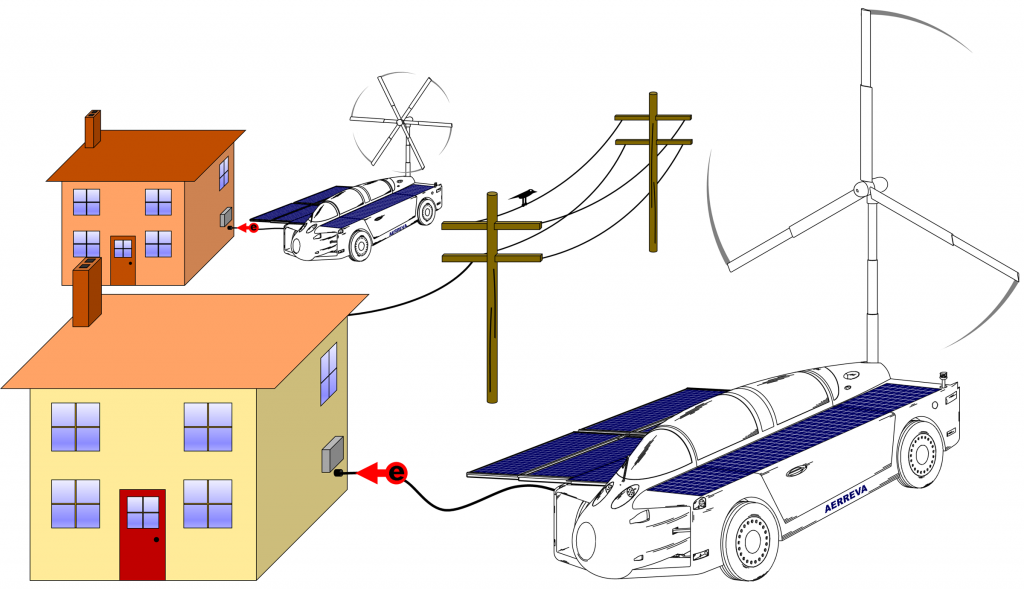
AERREVA H-Series
Electrical Grid and Electric Vehicles
Primary Energy Sources of Electricity
All-electric vehicles (EVs) run on electricity, which in the United States is produced mostly from fossil fuels (60.4%) and nuclear energy (18.2%). While electric vehicles emit no tailpipe emissions, using these fuel sources for recharging leads to significant pollution elsewhere. Additionally, these fuel sources waste around two thirds of their energy as waste heat in the power plant. No more green than gasoline powered cars. The amount of fossil fuels needed to fully recharge a 100 kWh battery, for example, requires burning either 142.5 pounds of coal or 927.5 cubic feet of natural gas, which includes plant-to-battery transfer losses. Energy used to extract, produce and transport these fuel sources varies, and is not included. For nuclear energy, a single uranium fuel pellet can recharge the battery over fourteen times. Producing uranium-235 has several issues such as widespread radioactive waste and accidents. Additionally, the process is highly energy-intensive, and the Energy Return on Investment (EROI) ratio can range from the teens to an energy sink depending on the source and ore grade.
Global Energy Crisis
Globally, proven reserves of oil, natural gas, coal, and uranium are estimated to last for another 57, 49, 139, and 90 years, respectively, at current consumption levels. In the United States, oil, natural gas, and coal reverses (mostly low grade bituminous and lignite coal), will last for around 5, 86, and 400 years, respectively, excluding new discoveries. Most of the uranium (95%) the U.S. uses in nuclear power plants is imported from other countries, which have higher grades of uranium ore. In Europe, the energy crisis in many EU nations is already ongoing, due to the reduction or elimination of gas supplies from Russia. As extracting oil becomes more energy-intensive, the automotive industry is expected to shift from predominantly gasoline-powered vehicles to all-electric ones. Electric cars would then rely mainly on natural gas and nuclear energy for their power. Once extracting natural gas also becomes more energy-intensive, coal is likely to become the main source of energy used to generate electricity.
Although solar and wind farms produce around 3.9%, and 10.2%, respectively, of total U.S. electricity production, they are intermittent and fluctuating sources of energy, with capacity factors of 28%, and 35% respectfully. Load-following power plants are therefore needed in order to deliver baseload power to consumers 24/7/365. Power plants that ramp up and down lose efficiency, and thereby release more emissions. Hydropower on the other hand, has a high EROI ratio, and can deliver baseload power 24/7, accounting for around 6.2% of total U.S. electricity production. However, power outputs still fluctuate due to water availability, which puts hydropower’s capacity factor in the 40% range. The electrical power grid is already under pressure, especially during summer months when people turn to their air conditioning systems & AC units. Adding tens of millions of electric vehicles would only strain it further, leading to more outages, and faster depletion of our energy resources. A link to the electrical grid, primary sources of energy and EV efficiency is further explored on our Electrical Grid page.
Solution for Clean Sustainable Transportation
Introducing the AERREVA self-charging all-electric vehicle concepts (SC-EV). The design concepts focuses on high mileage per kilowatt-hour, and high solar and wind energy output. By using renewable energy sources, the solar-wind hybrid subsystems are able to produce enough energy for daily commutes or long-distance trips without relying on the electrical grid. Main features include an extendable solar subsystem and wind generating subsystem that can be deployed in favorable weather conditions. Surplus energy, especially on windy days, can be used to partially or fully supply electricity to a home, and which through net metering, can also reduce a home owners utility bill with renewable energy credits. Depending on electricity rates, wind conditions, and the number of sunlight hours, home credits can range anywhere from around $100 to $500 per month.
The solar subsystem, housed in the upper deck, features retractable solar panels that can substantially increase the number of solar cells, and also tilt, tracking the sun. Tilting panels can produce much more solar power than stationary solar panels, which can only produce peak solar power when the suns rays are perpendicular to the solar panel. The horizontal axis wind turbine (HAWT) subsystem, stowed in the aft section, features a telescoping tower, extendable blades (energy output for a HAWT can be quadrupled by doubling its rotor diameter), and a wind tracking system. Once the vehicle is parked, the subsystems can then be activated automatically when favorable weather conditions are detected, or automatically stowed away during adverse weather such as hail, extreme winds, or icing, conditions that could cause damage to its subsystems, or parked in a car port or garage.
A small wind turbine that is directly connected to the battery charger has a number of advantages over a large distant wind farm. Firstly, there are no long-distance transmission losses. Secondly, maintenance is easier as there is no need to travel long distances or to climb tall towers. This results in less expensive repairs. Additionally, smaller turbines can be placed closer together, whereas a single large turbine requires up to 80 acres of land to avoid interference from other turbines. Smaller turbines have a lower blade tip speed (around 100 mph versus 180 mph), which reduces the chance of leading edge erosion, blade furniture detachment, delamination, or blade structural failure due to hitting birds, lightning strikes, rainfall, salt, dust, insects, and other airborne particulates. Replacing a damaged large wind turbine can be expensive, with the cost of a single blade reaching up to $300,000.
The vehicles main body construction features include centerline tandem seating that sits above the battery compartment, that can contribute to vehicle stability, handling, and protection of both passengers and batteries. Access to the batteries is located at the back end, where a slide-out tray that houses the batteries can be pulled from the vehicle. The battery compartment also serves as a seat and chassis support. The battery tray is versatile and can accommodate different types of batteries, such as lithium-ion, absorbent glass mat, or even lead-acid. The patent pending AERREVA H-Series has various models designed for different operating environments. Energy production estimates are available on the solar and wind energy pages. A new V-Series configured with a different type of wind turbine, that’s suited for areas with shifting winds is also in the works.
The H-Series is a combination of various wind turbines and solar panels that can be customized to suit different geographic locations. The HAWT is extendable and can be paired with either a tiltable (T) or non-tiltable (S) solar array subsystem. The number of blades on the turbine rotor can be varied to optimize performance in different wind conditions. More blades generate more torque in low wind conditions, while fewer blades, such as the 2nd and 3rd three-blade versions, are better for high wind conditions. Even blade configurations can be neatly stowed in the aft section of the vehicle, while the 3-blade model (3H) with the largest rotor diameter can be stowed as shown below. A tracking solar array is best suited for areas with low sun angles, while a non-tilting solar array is better suited for areas with high amounts of sunlight.
The four different configurations include:
TH – Tracking solar array with an HAWT fitted with an even number of blades.
SH – Extendable solar array (non-tracking) with an HAWT.
T3H – Tracking solar array with a three-blade HAWT.
S3H – Extendable solar array (non-tracking) with a three-blade HAWT.

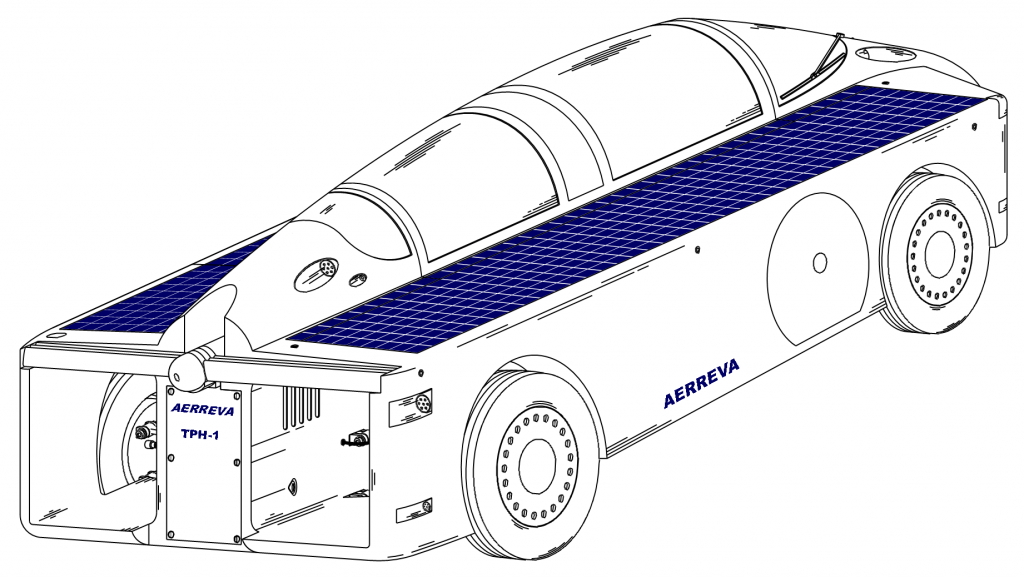
H-Series features
The vehicle has a cabin positioned at the center line to improve visibility, handling, and safety. It also has a lightweight design and a small frontal surface area for higher efficiency. The battery pack at the center line is removable. Other features include large bypass air channels for better aerodynamics, a horizontal axis wind turbine subsystem that can be extended, a top-side solar array for charging while on the go, and a retractable solar array subsystem. The vehicle also has sloped top side decks to allow rainwater to run off, an extendable anemometer for measuring wind speed and direction, a large cabin door for easy entry and exit, and removable overhead canopies for open-air driving or emergency exit. The vehicle has a radiator to cool the battery pack, dampers to cool solar cells and increase efficiency, all-around crumple zones to protect occupants, and easily removable seats. Its wide body offers stability and enables the accommodation of large solar and wind turbine subsystems. Moreover, most suspension components are protected from the airstream. The vehicle is equipped with side and rear view cameras and has a spare tire that is stored in the outer wall compartment.
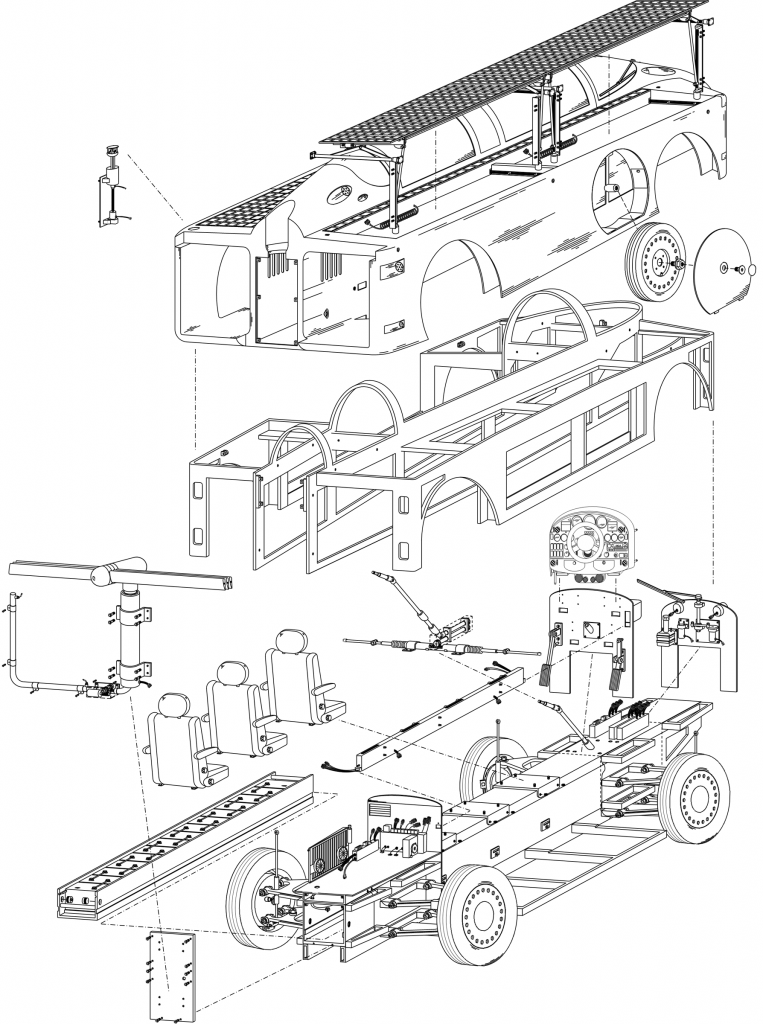
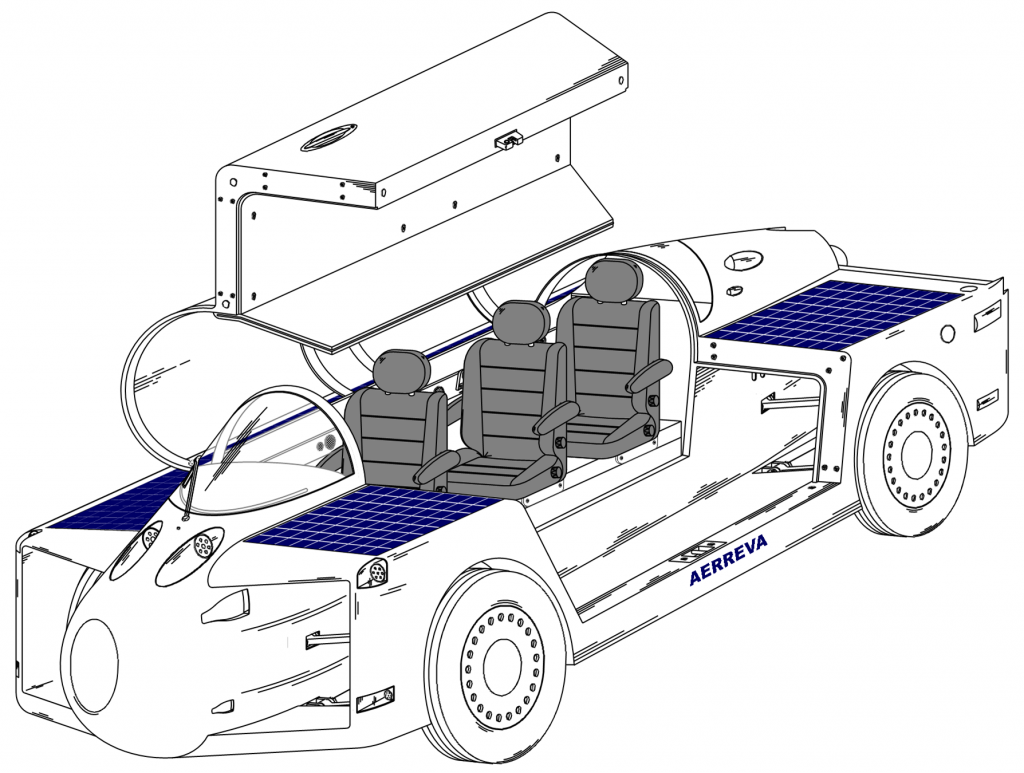
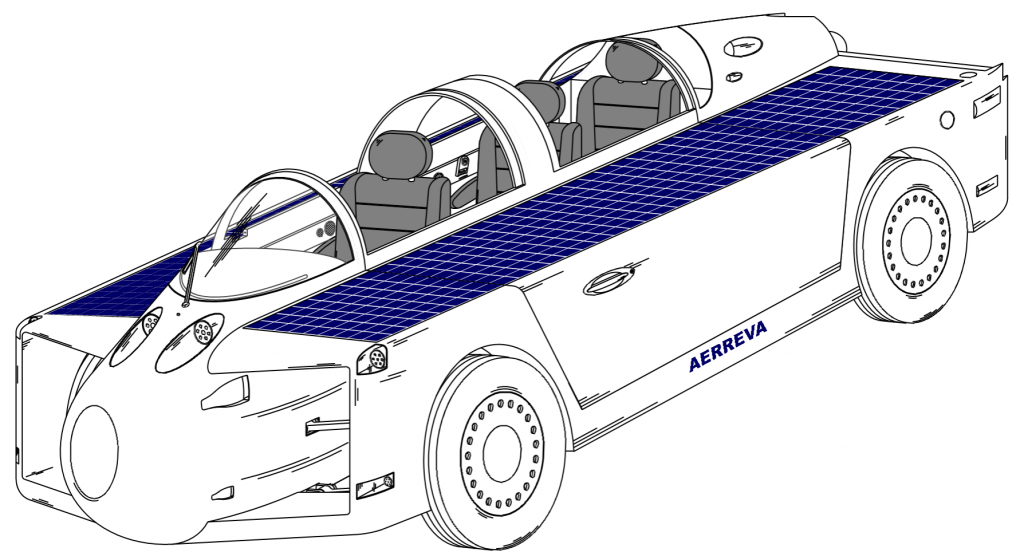
Battery Options
The battery pack, located centerline under the seats, is protected by belly panels and chassis rails. It can hold various types of batteries, including Lithium-ion and Absorbent Glass Mat. The estimated range is 1,885 km (1,171 miles) for Lithium-ion and 311 km (193 miles) for AGM. Larger battery packs increase range but also add weight, which increases rolling resistance. Lead acid batteries are better suited to subzero conditions, but have less than a quarter of the Watt Hours per Kilogram energy of Li-Ion batteries.
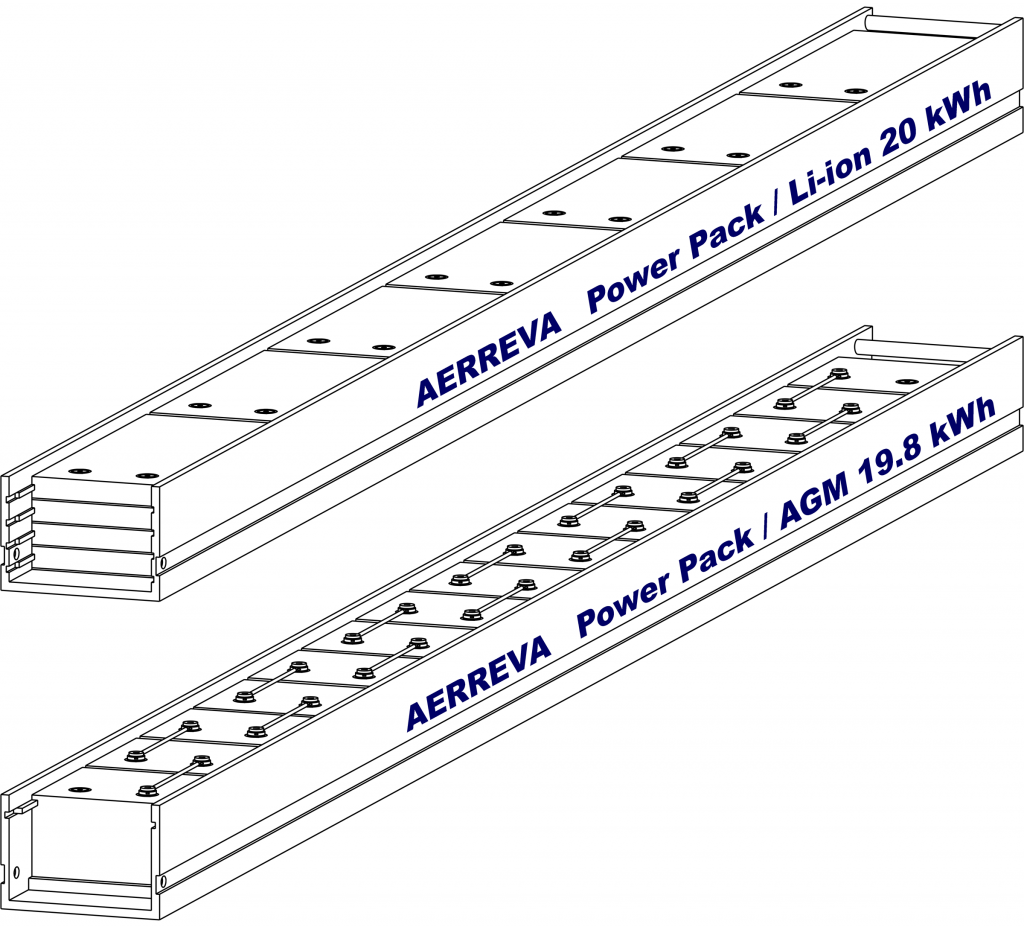
Lithium-ion and Absorbent Glass Mat (AGM) Battery Pack Options
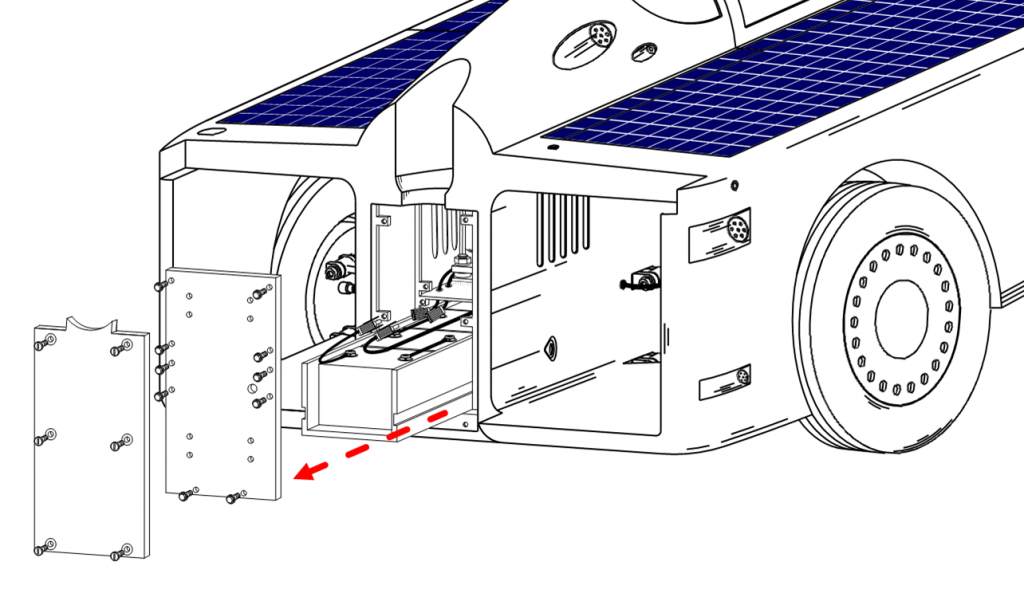
Battery Pack Removal
Generating Solar Energy
When the Sun sensor detects favorable conditions, it activates the solar array subsystem while parked.
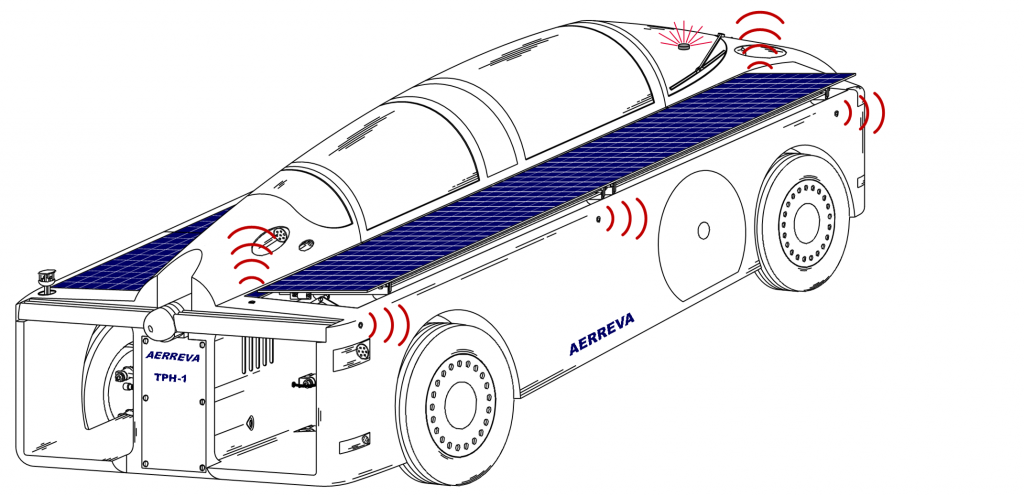
Once any obstructions are scanned, the solar array is activated.
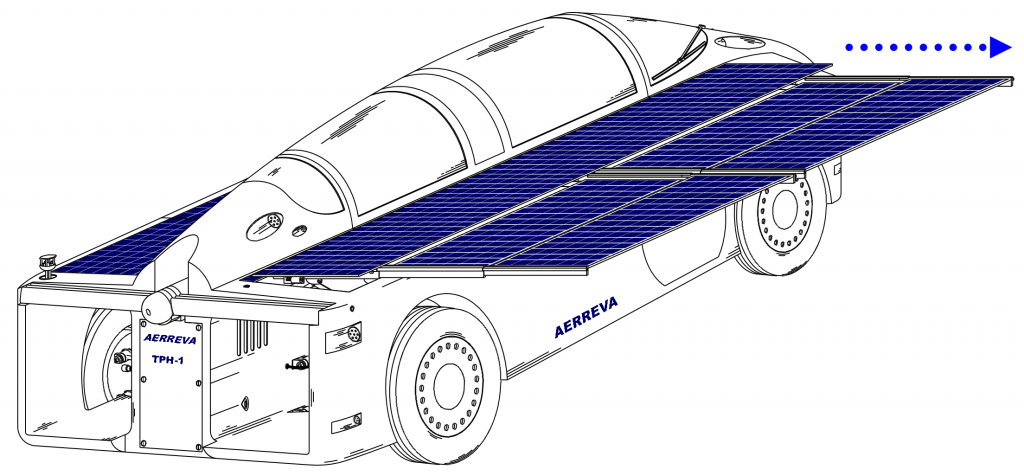
The solar panels are being extended.

The solar array has the capability to be tilted upwards.

Or angled downwards.
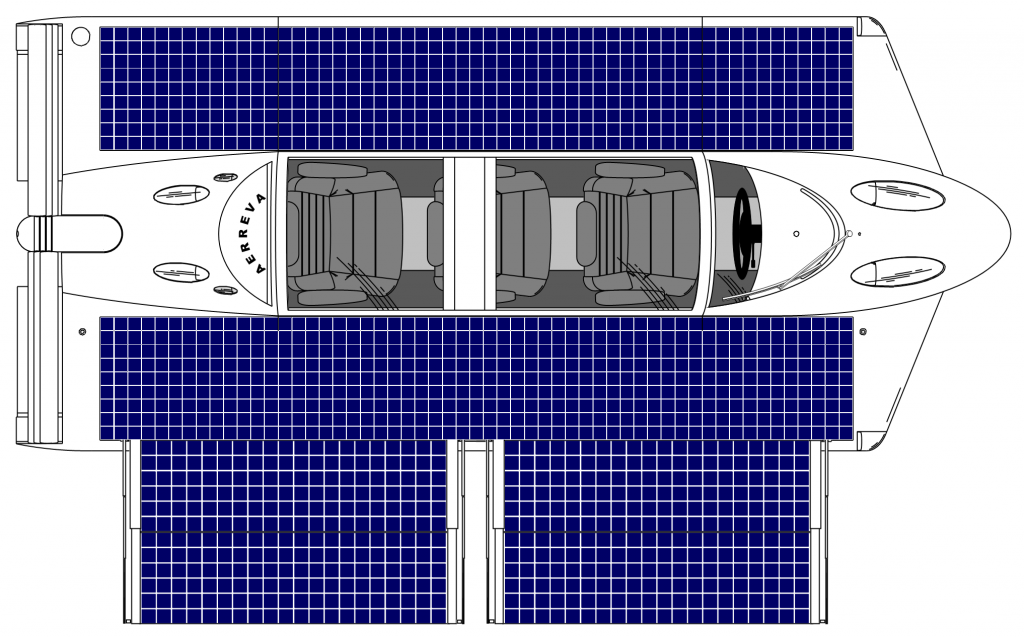
Solar Array Capacity
The energy produced by solar cells depends on various factors such as the Sun’s strength and angle, air quality, and the efficiency of the solar cells. At sea level, the Sun’s energy density is approximately 1,000 Watts per square meter. Solar cells with a 22% efficiency can produce up to 220 watts per square meter. When all the solar arrays are combined and positioned horizontally, they can generate 1,512 watts, or 7.56 kWh in one day, which can power a vehicle for daily trips of around 60 miles. Mileage estimates are based on an energy consumption of around 6.714 kilowatts per hour (kWh) or 122 watt hours per mile at 55 mph. However, tracking can more than double energy production, especially in winter months when the Sun’s angle is low. Production estimates are based on an average of 5 kWh per square meter of solar energy as shown by solar energy maps from the U.S. DOE, National Renewable Energy Laboratory. The amount of solar energy varies based on the region, with Southwestern states having more energy per day than Northeast parts of the U.S.
Generating Wind Energy
The vehicle’s wind turbine subsystem features a telescoping mast and rotor with extendable blades that can be stored in the rear section. An ultrasonic wind anemometer detects wind speed, duration, and direction to activate the turbine when favorable winds are detected when the vehicle is parked. The horizontal-axis wind turbine (HAWT) can have either an even number of blades (2, 4, 6) or a 3-blade version, which is the largest in the H-Series and produces the highest power output. Turbines with more blades provide more torque in low winds, while fewer blades increase the flow speed and are better suited for high wind conditions. When the vehicle is parked, the various HAWT subsystems can be activated when favorable conditions are detected.
3 Blade HAWT
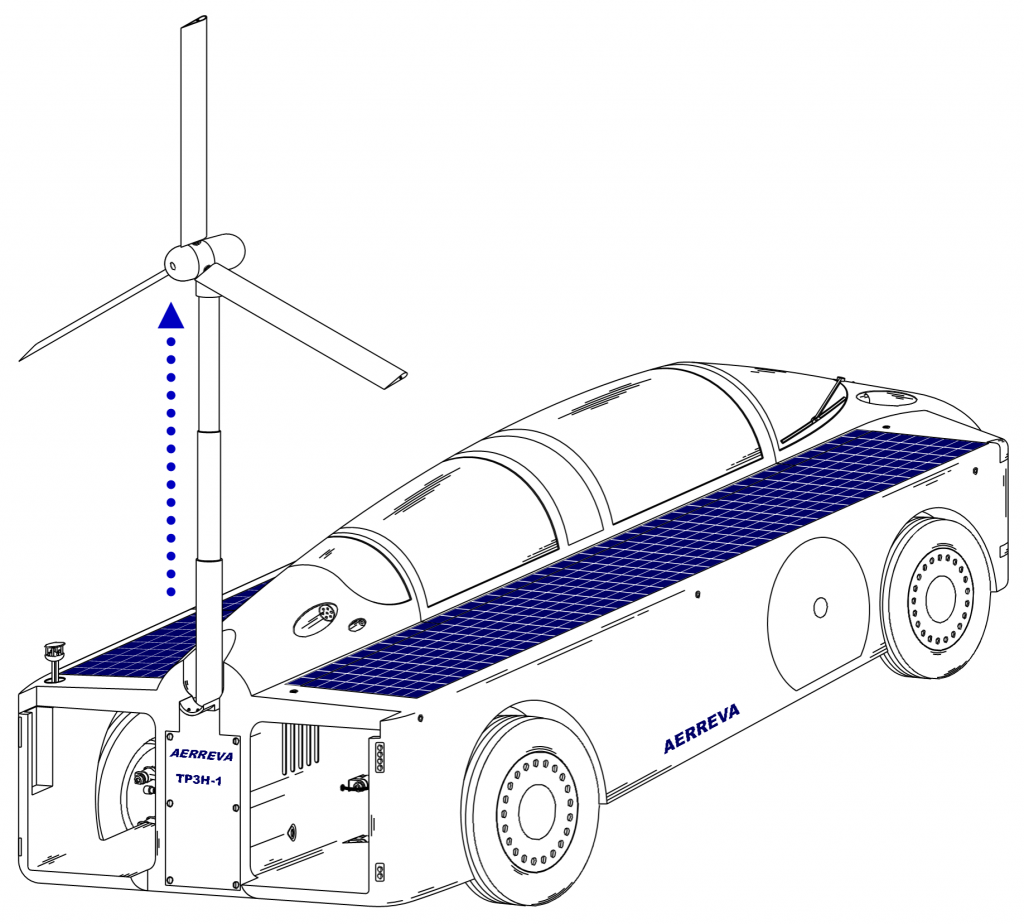
The tower is extended.

The blades have been extended and rotated from their feathered position.
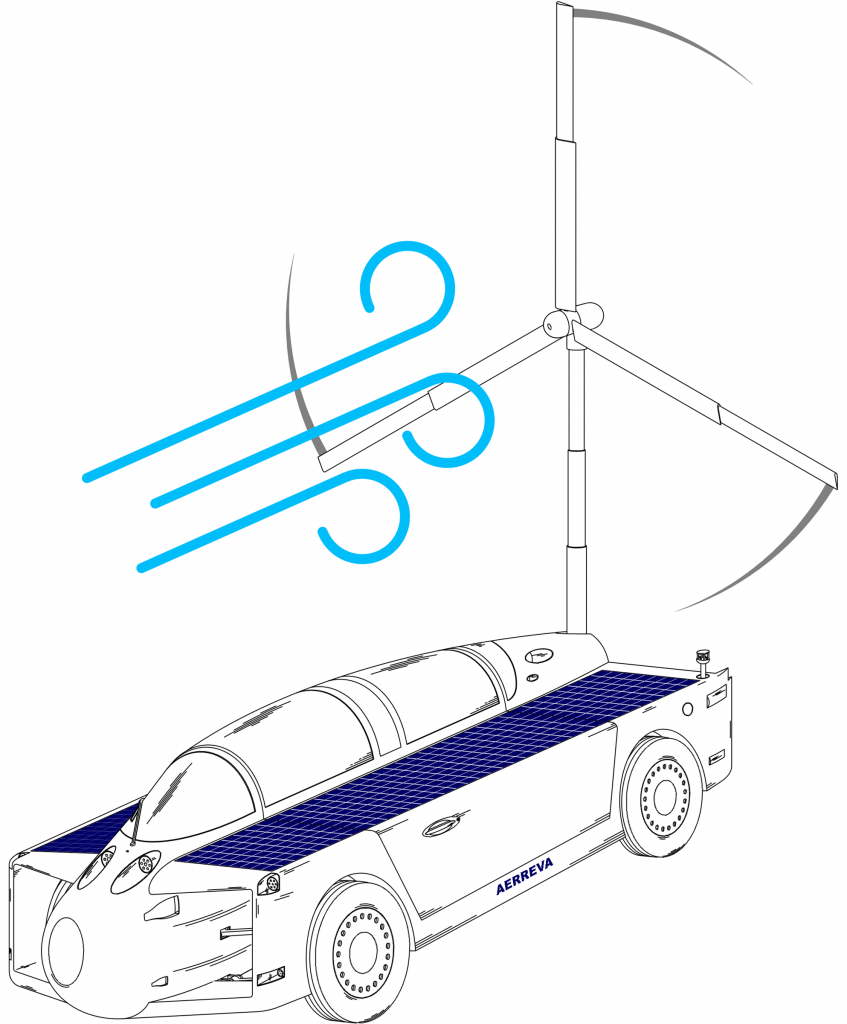
The turbine is rotated to face the wind.
6 Blade HAWT
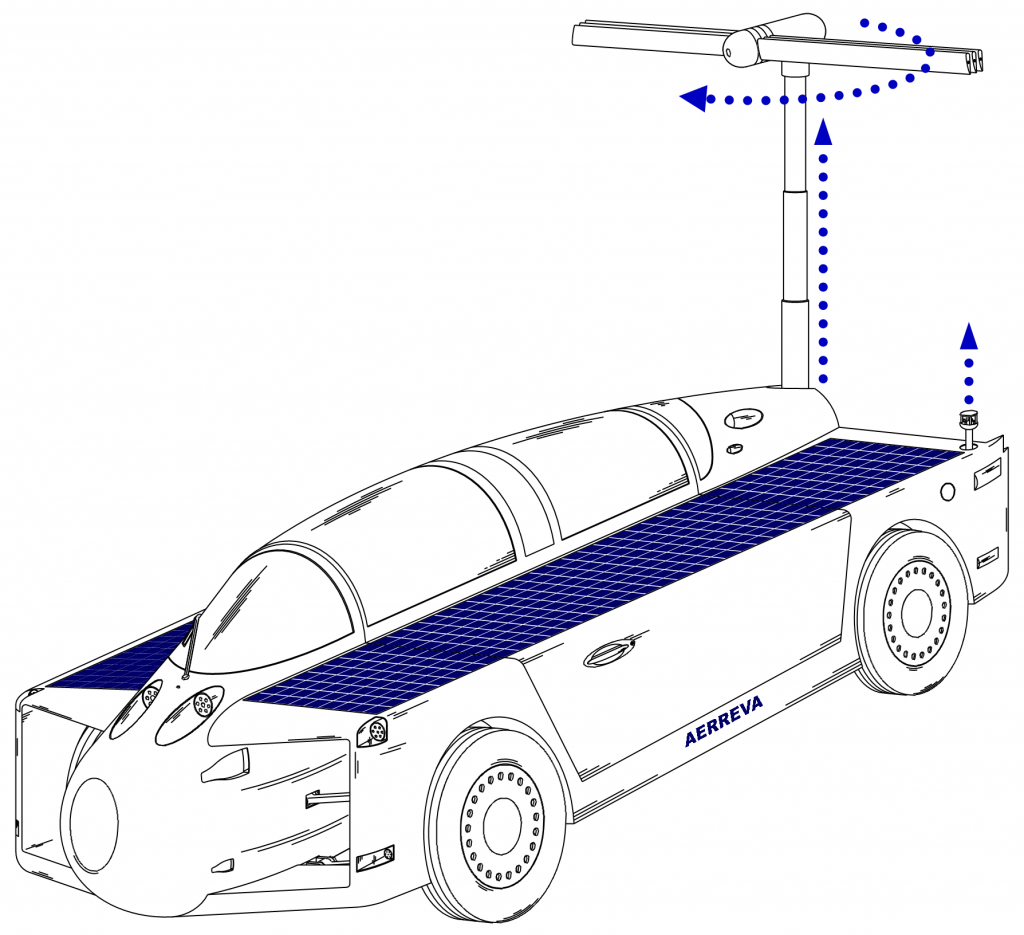
The tower has been extended and the turbine has been rotated to face the wind.
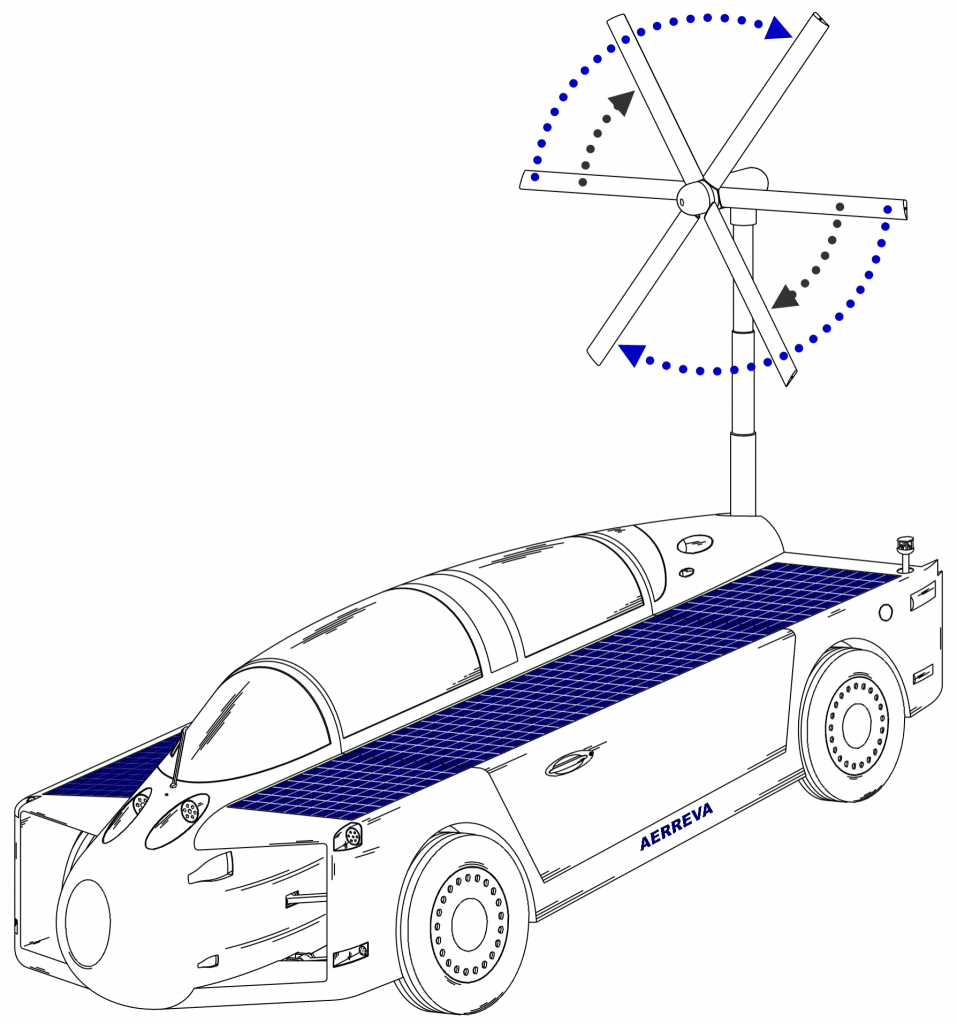
The hubs can be rotated and then locked into place.
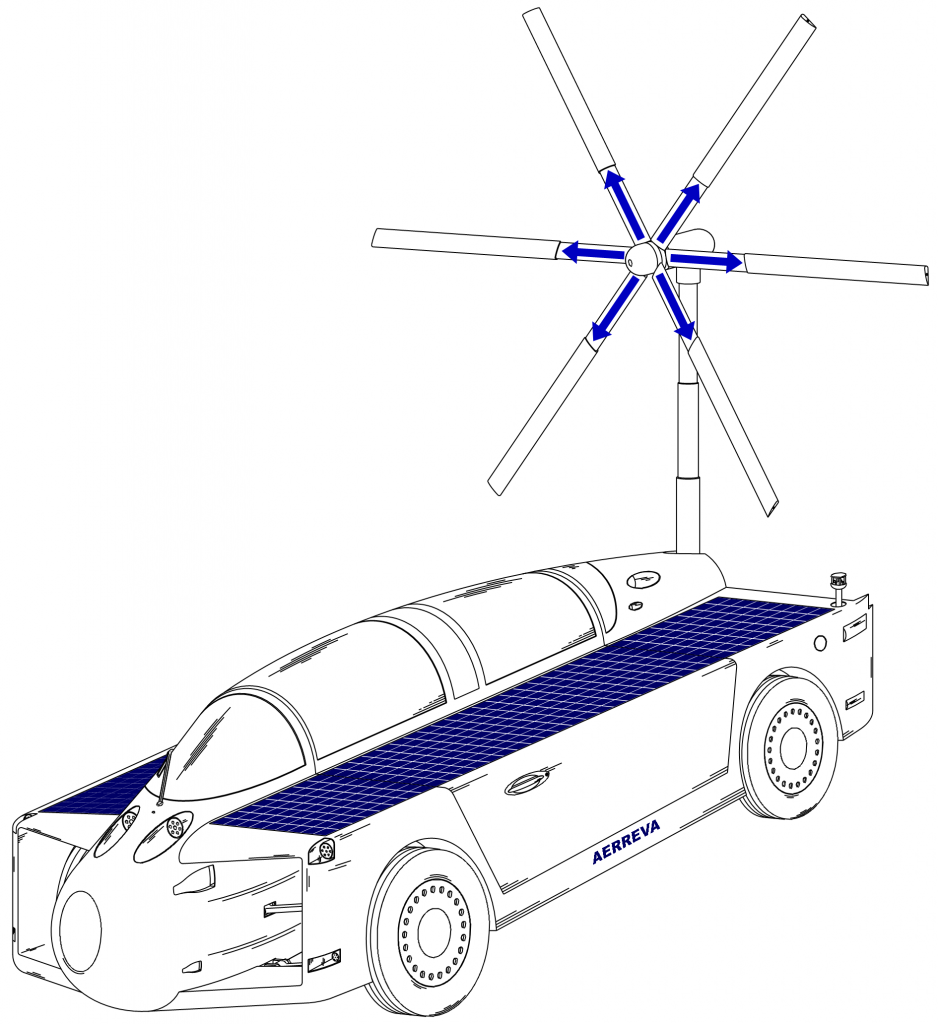
Blades are extended.
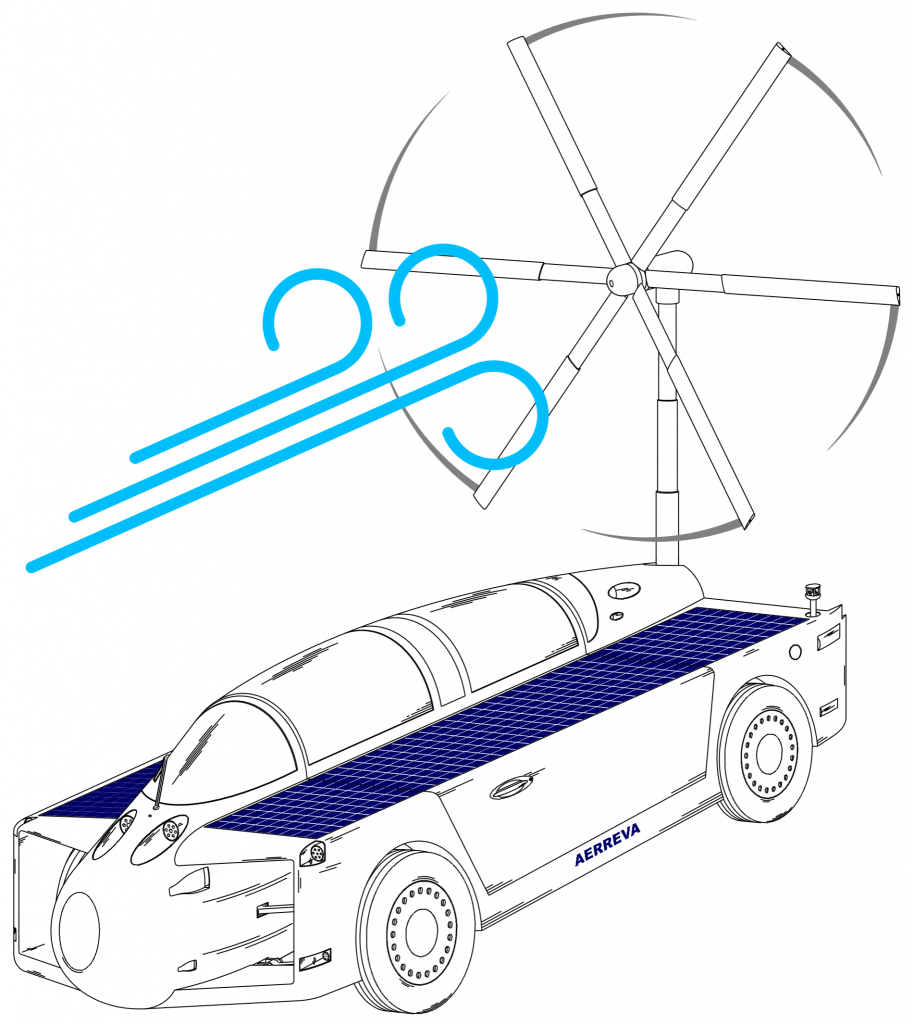
Wind turbine is fully deployed
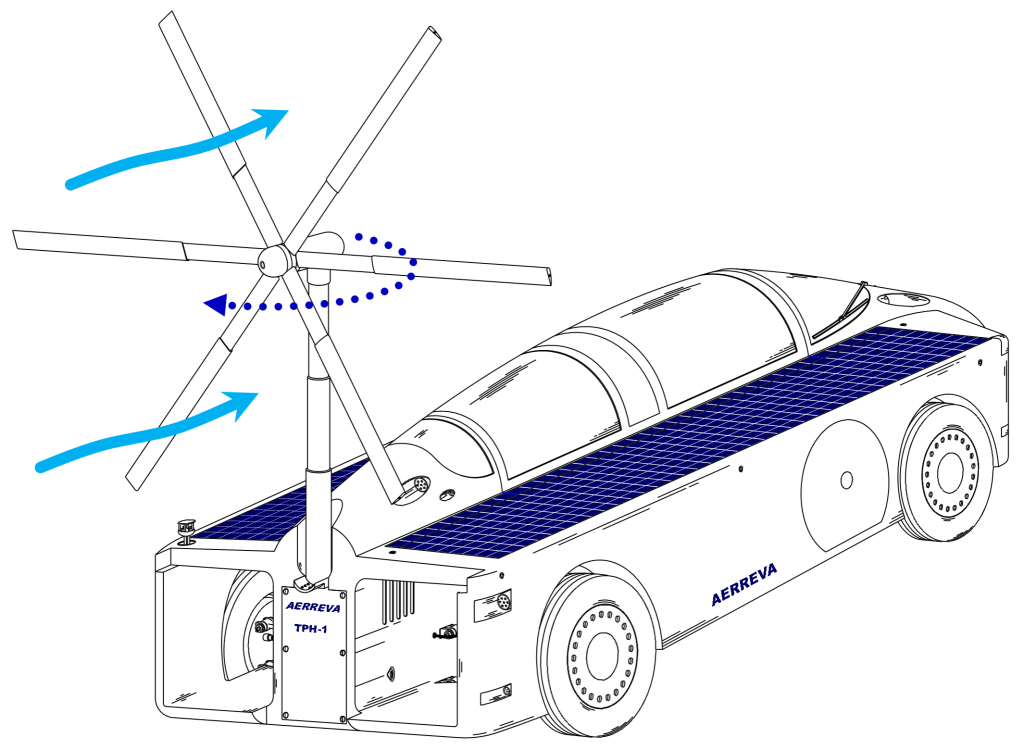
The turbine is designed to rotate in order to follow the direction of the wind.
The other blade configurations, a 4-blade, are not currently displayed.
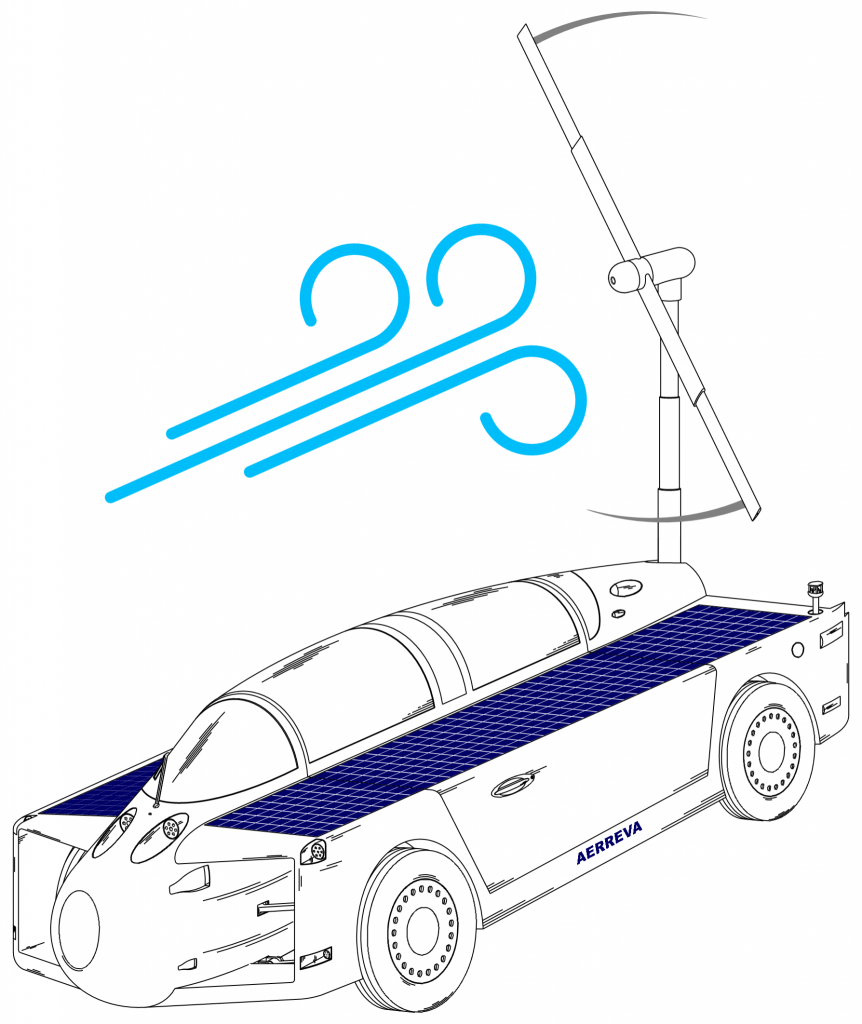
| Rotor Diameter | Wind Speed | Wind Speed |
| 6 feet | 15 mph -> 130 watts | 30 mph -> 1,169 watts |
| 9 feet | 15 mph -> 294 watts | 30 mph -> 2,640 watts |
| 11 feet | 15 mph -> 441 watts | 30 mph -> 3,950 watts |
Wind speeds of 20 mph or more in areas like the Midwest and Great Plains can generate enough energy in 24 hours to power a vehicle for 500 miles, and more with stronger winds. Mileage estimates are based on energy consumption of about 6.714 kWh or 122 watt hours per mile at 55 mph.

Solar Energy + Wind Energy
Over 30 days, the solar panels and wind turbine can produce a total of 3,070 kWh of energy. This amount of energy is capable of charging an 80 kWh battery pack 39 times. For additional examples of renewable energy production, please visit our solar and wind energy pages.
Energy is Money
Net billing or net metering with AERREVA electric vehicles can help lower the electricity bills of a household. Electricity rates vary from state to state, with Hawaii having one of the highest rates at an average of 46.52 cents per kilowatt-hour (kWh), while Nebraska charges around 10.58 cents per kWh. By combining the energy output from solar and wind sources, it’s possible to generate approximately 1,068 kWh of energy every month, with renewable energy credits amounting to around $113.00 in Nebraska and $496.83 in Hawaii. As the demand for energy increases and the shift to more expensive energy sources takes place, electricity prices are projected to rise.
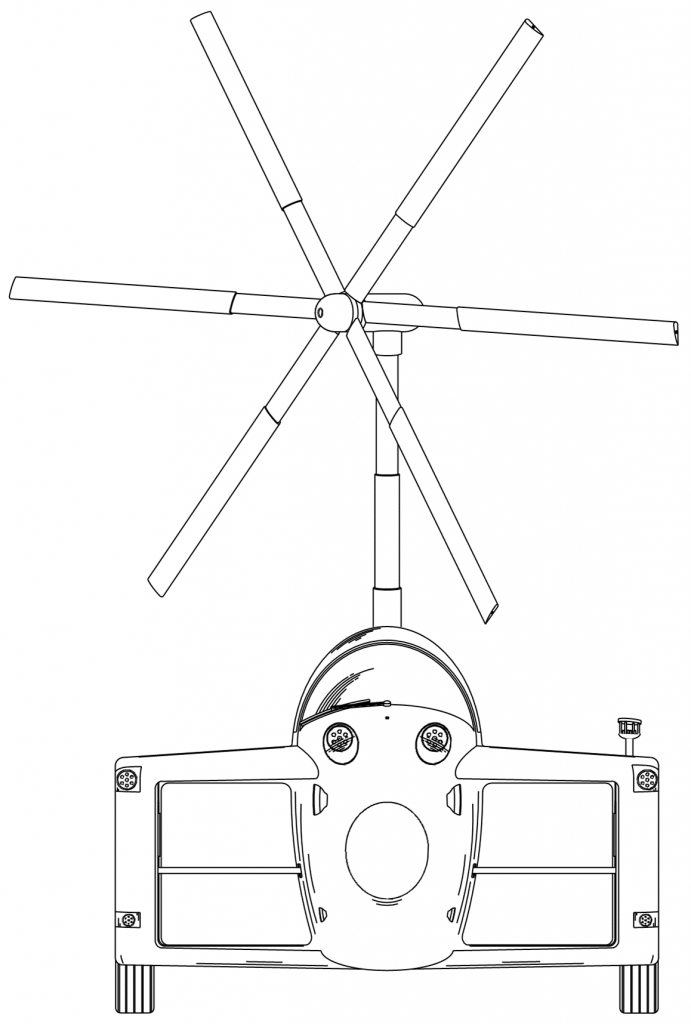
Nationwide Wind Energy Potential
Small wind turbines can produce significant energy. One million turbines generating 28 million kWh can power almost a million homes in 20 mph winds for 24 hours. At 30 mph winds, the same number of turbines could power four million homes. Even with 15 mph winds, 10 million kWh could be produced daily, enough to power half a million homes.
(28 kWh x 1,000,000 = 28,000,000 kWh) (20 mph winds/24 hours).
(94 kWh x 1,000,000 = 94,000,000 kWh) (30 mph winds/24 hours).
10,000,000 kWh (10 mph winds/24 hours).

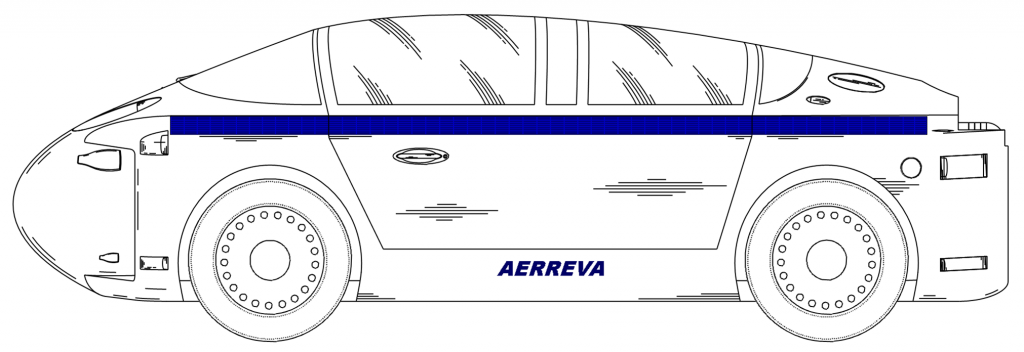

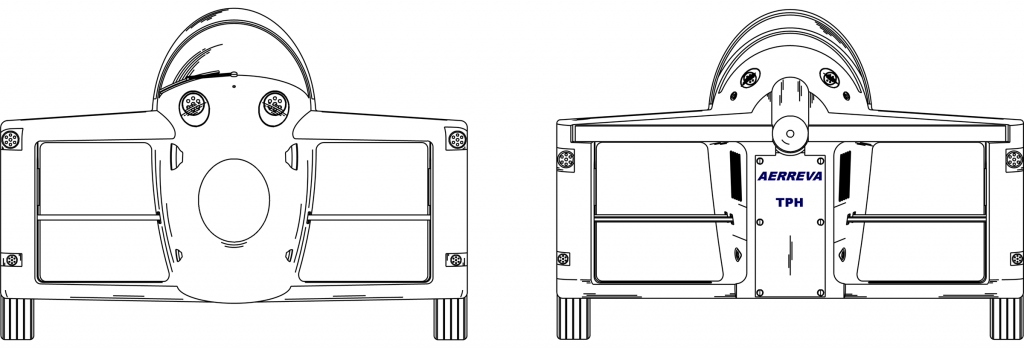
Energy Production Estimates
The estimates for solar and wind energy production do not account for the fact that an average car is parked around 95% of the time. Additionally, the DC to AC conversion efficiency has not been considered.
Development Stage
AERREVA H-Series EVs are currently in the early stages of development, from conceptual drawings to patent applications and prototypes. The next step is to build a functioning prototype. The vehicle and its wind and solar subsystems and methods are Patent Pending (Utility Patent Application) filed by DLA Piper LLP (US), a global company that provides intellectual property and patent services. They have been extremely helpful, providing information and guidance throughout the process.
Acknowledgments
The author acknowledges the National Aeronautics and Space Administration (NASA), the United States Environmental Protection Agency (EPA), the United States Department of Energy (DOE), the U.S. Energy Information Administration (EIA), and the National Renewable Energy Laboratory (NREL) for providing data.
Other AERREVA series
Currently in development are various AERREVA series and their variants. This includes a larger horizontal-axis wind turbine with a tower design, a larger solar array subsystem that can be attached to any variant, a new type of wind turbine that is more suitable for urban areas where wind direction changes frequently, and a wider cabin design for increased seating
LH – larger HAWT and tower.
LSP – larger solar array subsystem.
V Series – new type of wind turbine.
W Series – wider cabin.